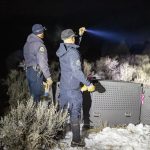Garfield Clean Energy Column: The future of vehicles is (still) electric
Garfield Clean Energy

Courtesy
The future of driving rolled into Carbondale last week, and the energy was electric. More than 40 Garfield County residents got behind the wheel of the latest electric vehicles (EVs) at the EV Roadshow, experiencing firsthand the smooth, quiet ride. The joy on drivers’ faces was contagious, especially when driving the lime green Volkswagen ID Buzz — a take on the iconic Volkswagen Vanagon.
Garfield County is a great place to own an EV. More than 1,600 EVs cruise along our roads and charging gets easier by the day with more than 150 charging ports throughout the county. That’s 15 Level-2 ports per vehicle. Find a charger close to home and on the road through PlugShare.
Then there are the financial and emissions benefits: EVs have about 50% lower long-term maintenance costs and cost 60% less to fuel. Plus, they provide a fun driving experience with quick acceleration, easy handling and zero tailpipe emissions.
And with big changes coming to federal and state incentives, including the expiration of the $7,500 federal tax credit on Sept. 30, 2025, now is the perfect time to explore what EV ownership could look like for you. Rebates may be shifting, but EVs aren’t going anywhere. For those of us working in clean transportation, the message is simple: the future is still electric.
What you need to know about federal and state rebates
The federal tax credit for new and used EVs only applies to a subset of vehicles. The car must meet certain manufacturing and battery sourcing requirements to qualify. Some manufacturers have eligible models, and some dealerships offer a $7,500 discount to make up for vehicles that don’t qualify for the federal tax credit. If you’re interested in making the switch, meet the income requirements and have your eye on an EV on the FuelEconomy.gov list, now is the time to act.
Colorado has additional EV incentives that won’t expire at the end of this month. They can be stacked on top of the federal tax credit while it lasts. State incentives include $3,500 for any EV with an MSRP under $80,000 and a bonus $2,500 for an EV with an MSRP under $35,000. However, the base incentive of $3,500 for any EV is decreasing to $750 at the end of 2025.
Another rebate to consider is Colorado’s Vehicle Exchange Colorado (VXC) program. It offers a stackable $6,000 rebate for new cars and $4,000 for used ones. To qualify, your current gas car must be at least twelve years old or fail a Colorado emissions test. Participants also must have an income below 80% of the area median income and work with a participating dealership like Bighorn Toyota, Glenwood Springs Ford, Mountain Chevrolet, Phil Long Glenwood Springs Subaru and Columbine Ford. VXC rebates are increasing on October 1st to $9,000 (new) and $6,000 (used) to offer some relief as the federal tax credits expire. The VXC rebate is generally applied at the point of sale, whether that is on your lease, monthly payment or cash cost.
How to get started
Buying a car can be complicated. Start with an EV finder tool to see what’s available. Then, work with a dealership to ensure your vehicle is eligible for incentives and where they’re applied. Many dealerships prefer to apply the federal and Colorado tax credits to financing or lease monthly payments (some leases are as low as $99 a month). If you are looking to purchase a vehicle to own, you may have to apply for the tax credit incentives on your taxes.
Or, participate in one of several more EV Roadshows with workshops and test drives in the region throughout September and October, including an informational session in Glenwood Springs on Oct. 16. EV enthusiasts and the EV curious can attend these upcoming events to discuss and ask questions about electrifying fleets, charging at multifamily housing, rebates and incentives, and vehicle models.
Dova Castañeda Zilly is the Clean Mobility Program Manager at Clean Energy Economy for the Region (CLEER), the nonprofit that manages the programs of Garfield Clean Energy.

Support Local Journalism

Support Local Journalism
Readers around Glenwood Springs and Garfield County make the Post Independent’s work possible. Your financial contribution supports our efforts to deliver quality, locally relevant journalism.
Now more than ever, your support is critical to help us keep our community informed about the evolving coronavirus pandemic and the impact it is having locally. Every contribution, however large or small, will make a difference.
Each donation will be used exclusively for the development and creation of increased news coverage.









